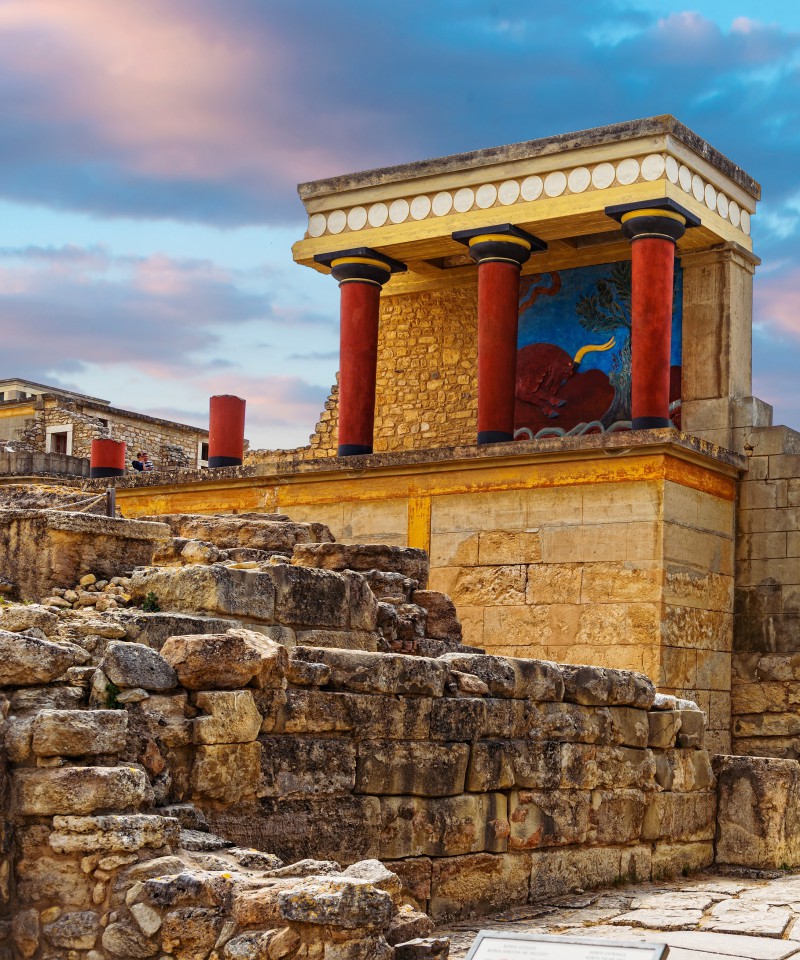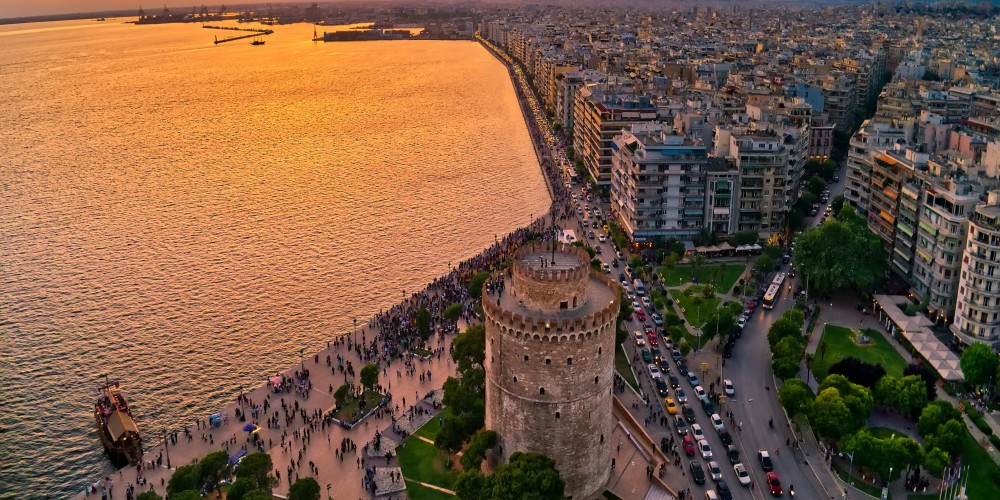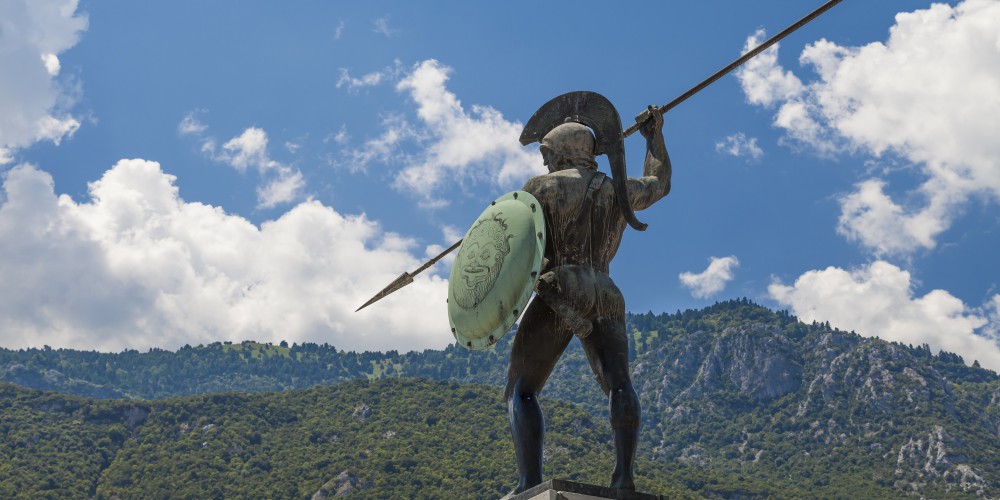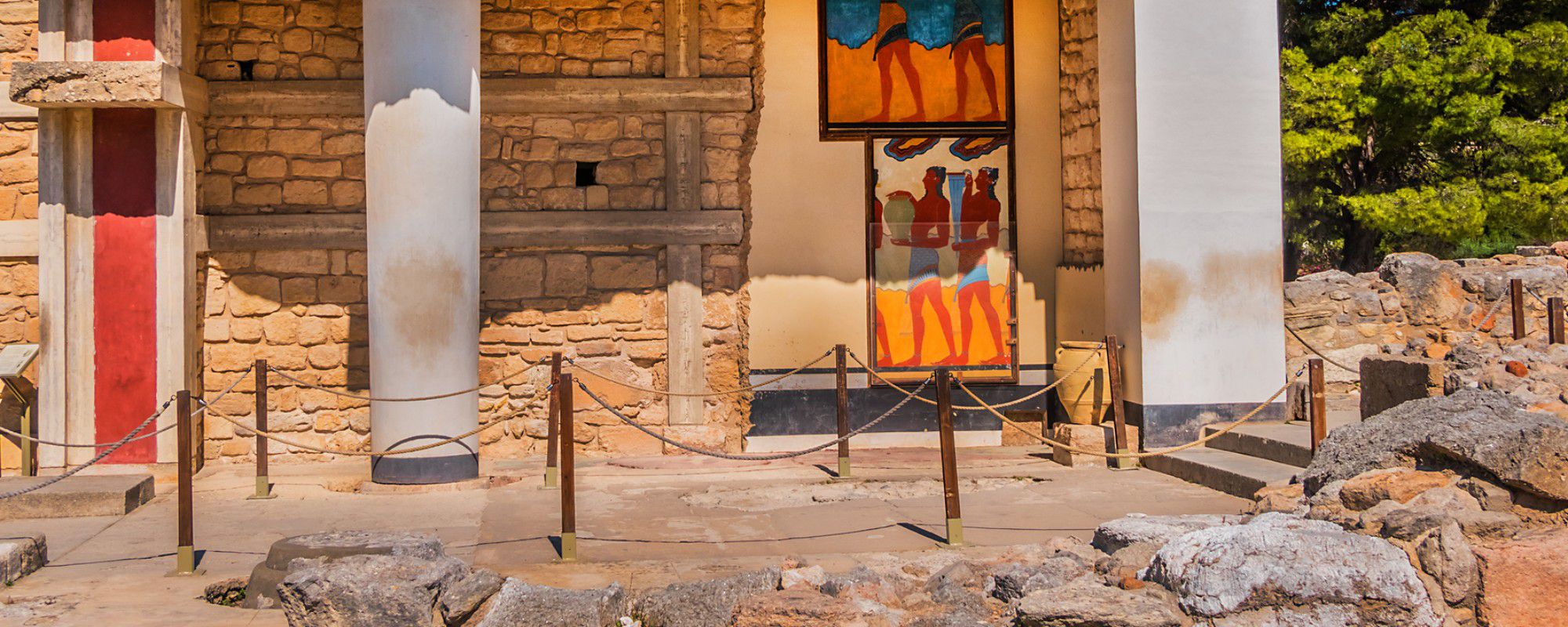
The Most Fascinating Greek Ruins
Key Takeaways
- Many Greek ruins have been recognized as UNESCO World Heritage Sites.
- Greece has a rich ancient history and is home to numerous archaeological sites and attractions that showcase its cultural heritage.
- The Acropolis of Athens, the ancient ruins of Delphi, the ancient city of Olympia, and the archaeological sites of Mycenae and Tiryns are some of the most important sites in Greece.
- Greece's historical and cultural heritage is not limited to mainland Greece, as there are also significant sites on the Greek islands.
Do you plan on visiting Greece for its staggering ancient history and culture, but you don’t know which archaeological sites and Greek attractions you should visit first?
Here is a list of the most important Greek ruins worth your time!
Athens may well be the cradle of Democracy and Western civilization, but other places in Greece host must-see archeological gems as well!
Most ancient Greek ruins have been listed as UNESCO World Heritage Sites.
However, there are some that haven't without being any less significant. As a result, we have distinguished between those recognized and those who haven't for your convenience.
UNESCO World Heritage Sites to Visit in Greece
The ancient city of Delphi - credits: Sergey-Novikov/Shutterstock.com
It all started on November 16, 1972, when the UNESCO General Congress passed the Treaty on the Protection of the World Cultural and Natural Heritage.
In a nutshell, this Treaty states that the signatory states recognize that the regions in their national territory that have been inscribed on the list constitute, without prejudice to national sovereignty and property rights, a world heritage 'for the protection of which the international community is responsible, which must work as a whole for this purpose.'
For its part, UNESCO helps states protect these sites by providing technical assistance, vocational training, and emergency financial assistance to areas in immediate danger.
For the inclusion of a monument in the list, its criteria are nicely summarized in these two sentences: 'to show important human values for a long period of time" and "to bear a unique or at least excellent testimony to a cultural tradition, living or extinct culture.'
To be selected as a World Heritage Site, it must be a unique landmark that is geographically and historically recognizable and of particular cultural or natural significance.
Greece has 18 monuments on this list, which receive legal protection from the organization. Let's see below what they are, and let's remember parts of Greek history.
The Acropolis of Athens
The Acropolis of Athens - credits: greece-is
The Acropolis is the most well-known monument in Greece.
It dates back to the 5th century BC, and it accurately depicts the glory of the Golden Age of Pericles in the fifth century. It is mainly dedicated to Athena, the patron goddess of the city.
There are several iconic ruins in the Acropolis, with the most popular ones being the Parthenon, the Erechtheion, the Temple of Athena Nike, and the Propylaea. Replicas of the famous sculptures of Caryatides decorate the porch of the Erechtheion.
At the same time, the original artifacts are exhibited in the new Acropolis Museum, which is located just opposite Acropolis Hill.
The Parthenon is arguably one of the most impressive buildings on the site. With the temple being dedicated to the goddess Athena, the eastern pediment depicts her birth, which happened through Zeus’ head, according to Greek Mythology.
At the same time, the western part of the pediment depicts the battle between Athena and Poseidon, who fought over who would become the city's patron.
The Acropolis is an excellent sample of classical Greek art and architecture, which justifies its place among one of the seven wonders of the ancient world. When you visit it along with the Acropolis Museum, be sure that it will leave you speechless!
Please note that the Acropolis Museum, the Heraklion Archaeological Museum, and the National Archaeological Museum are the top three museums of historical interest in Greece.
The Ancient Ruins of Delphi
The ancient Greek sanctuary of Delphi - credits: epostravel-tours
The ancient Greek sanctuary of Delphi, where the oracle of Apollo was located, was the location the ancient Greeks described as the ‘navel of the world’.
Harmoniously combined with the beautiful landscape and sacred significance, Delphi in the 6th century BC was indeed the religious center and symbol of unity of the ancient Greek world.
At the foot of Mount Parnassos is the famous oracle of ancient Greece, where the oracle of Apollo was given. Ancient Delphi was the religious and spiritual center of Greek antiquity for many centuries, and the oracle's fame reached the ends of the world.
Moreover, the oracle of Delphi is believed to have made important predictions regarding important events such as the Trojan War.
Delphi ancient site- credits: elgreko/Shutterstock.com
In ancient Greece, it was unheard of to go to war without first receiving advice from Pythia, the priestess of the Oracle of Delphi, the most trustworthy oracle of the ancient world.
Pythia was a messenger of god Apollo, and no one dared doubt her oracles.
The earliest findings in the area of Delphi date back to the Neolithic period. Unfortunately, they are fragmentary until the 8th century BC, with substantial proof of occupation evident only after the establishment of the Oracle.
The Oracle maintained its glamor for two centuries, and during the 6th century, the sanctuary became independent, with its political and religious influence soaring and the first Pythian Games taking place.
From then on, the Pythian Games were held every four years and were the second most important Games in Greece, after the Olympics. Today, Delphi is one of Greece's most famous archaeological sites, one you should experience firsthand!
The Ancient City of Olympia
The important Archaeological Site of Olympia - credits: lonelyplanet.com
In the western Peloponnese, in the valley of the river Alpheus, Olympia flourished the most glorious sanctuary of ancient Greece, dedicated to the father of the gods, Zeus.
Olympia was established as the most important religious and sports center.
At the archaeological site of Olympia, the great Olympic Games were born. They took place every four years in honor of Zeus and, to this day, are the most prominent world sporting event.
The beginning of the cult and the mythical matches in Olympia are lost in the depths of the centuries.
Nevertheless, local myths about the mighty king of the region, the famous Pelops, and the river god Alpheus reveal the strong ties of the sanctuary with both the East and the West.
The sanctuary was dedicated to Zeus, the father of gods and humans.
However, besides the Temple of Zeus, Olympia hosts many other historical buildings. Most of the buildings were constructed in the 4th century BC, and many of them have survived, reminding us of Olympia’s bright past.
Many ancient buildings were used by the athletes of the Olympic Games for training and celebrating their wins.
If you visit the Peloponnese, it would be a grave omission not to visit Olympia! Keep in mind that there are still events in Olympia keeping the ancient spirit alive.
The Olympic Torch that signifies the beginning of the Olympic Games is ignited every year through a reaction caused when the sun hits a parabolic mirror.
Eleven women are dressed up representing the Vestal Virgins and perform a celebration at the Temple of Hera. If folklore tradition is your cup of tea, you will love the event!
The Archeological Site of Mycenae and Tiryns
The Archaeological site of Mycenae and Tiryns - credits: greeka.com
Ancient Mycenae and Tiryns are two cities associated with the Homeric Epics, Odyssey, and Iliad, which have been a model for European art and literature for thousands of years.
The archeological sites of these two cities are outstanding monuments of the Mycenaean civilization that flourished in the eastern Mediterranean and left its mark over the centuries.
According to Pausanias, Perseus built Mycenae in Tiryns and gave them this name either because the ‘fungus’ (the case) from his sword fell there or because while he was thirsty, he found a ‘fungus’ (a mushroom) and when he pulled it he saw the source of Persia, which still exists today.
The archeological sites of Mycenae and Tiryns are well-preserved sites of the two largest cities of the Mycenaean civilization, which dominated the eastern Mediterranean world from the 15th to the 12th century BC. and played a vital role in the development of classical Greece and its culture.
Mycenae lies northern to the city of Argos on the top of a low hill that overlooks the valley, stretching to the shores of the Argolic Gulf.
Built on a naturally fortified location, the Acropolis of Mycenae is the first thing visitors see when they set foot in the region.
With colossal stone blocks put into creating an impenetrable wall for the protection of the 'Anax' and his people, ancient Mycenae was for sure one of the most progressive and impressive places of prehistoric Greece.
Don't miss the chance to visit the birthplace of Agamemnon and relive the history of Mycenae through the words of the most revered poet in human history, Homer.
During your visit, relive the stories of the Trojan War, visit massive tombs of Kings and Queens, and walk around the palatial complex of Mycenae surrounded by the impressive Cyclopean walls!
The Medieval City of Rhodes
The Medieval City of Rhodes - credits: discovergreece.com
While most ancient Greek temples and ancient cities are found in mainland Greece, there are incredible relics on the islands as well.
Walking in the medieval streets of the Greek island of Rhodes, one will feel that time has frozen in the time of the knights. The famous Order of Ioannina occupied Rhodes from 1309 to 1523 and left behind a great gem of architecture.
The Palace of the Great Lords, the Hospital, and the Road of the Knights make the Upper City of Rhodes an important monument of the Gothic period.
The medieval city of Rhodes, a UNESCO World Heritage Site since 1988, was developed without any specific urban planning around the fortress-citadel of the city of Rhodes, probably after the earthquake of 515.
The fortress was divided into two distinct urban formations in ancient times, the Kollakio North and Chora South.
Kollakio includes the well-known street of the Knights, the Palace of the Grand Master or Castello, the Hospital that has been turned into a museum, the temples of the Order, and other important buildings.
In its Chora, one can find the Turkish bazaar around the Suleiman Mosque, the old market, and other buildings of tourist interest.
The Old Town of Corfu
The Old Town of Corfu - credits: corfusecret. gr
Another ancient site not located in mainland Greece is the Old Town of Corfu.
It is bordered by the Old and New Fortress, created during the Venetian occupation to protect the town from the Ottomans and it is one of the most spectacular ruins in the country.
The historic center of Corfu is reminiscent of something from Italy, which is not unreasonable as the rule of the Venetians on the island lasted about 400 years.
The island escaped the Turkish conquerors and managed to flourish and stand out from the rest of Greece.
The Old Town of Corfu is included in the list of world natural and cultural heritage monuments as a remarkable architectural symbol representing a critical historical period.
Its registration was adopted unanimously after a positive recommendation from the international non-governmental organization ICOMOS (International Council for Monuments and Sites).
It is a Byzantine settlement of the 6th and 7th centuries AD.
The Paleochristian and Byzantine Monuments of Thessaloniki
Paleochristian and Byzantine monuments of Thessaloniki - credits: gtp.gr
The second most important city in Greece, Thessaloniki, was founded in 315 and was one of the first centers of the spread of Christianity.
Among its Christian monuments are pre-Christian temples and three-aisled royal churches.
They were built from the 4th to the 15th century and constitute a timeless typological series that significantly influenced the Byzantine world.
The Rotunda, St. Demetrius, and St. David mosaics are among the most important masterpieces of early Christian art.
Rotunda: The Rotunda belongs to the pericentric buildings, while its circular shape is what prompted its name. It was built in the years of Caesar Galerius, around 306 AD, as a temple for Zeus or, according to others, as a Mausoleum.
In the center of Thessaloniki, on Agias Sofias Street and north of the homonymous church, the church of Achiropoietos is preserved.
Its date of construction is placed around the middle of the 5th century. Achiropoietos is part of the type of three-aisled wooden-roofed basilica with an attic, which ends in a semicircular arch to the east.
Church of Agios Dimitrios: It was built on the ruins of a Roman bath. The first church, a small prayer hall, was built after 313. In the 5th century, the prefect Leontios built a sizeable three-aisled basilica, which burned in 626 - 34, immediately after the five-aisled basilica was built.
In 1493, it was converted into a mosque. In 1912, it was returned to Christian worship. It burned down in the great fire of 1917 and reopened in 1949 after its restoration was completed.
Latomou Monastery: It was built on a Roman building in the late 5th - early 6th century. In 1430, with the fall of Thessaloniki, it was turned into a mosque, while the mosaic was covered with plaster. In 1921 it was attributed to Christian worship, and then the mosaic was discovered. The monument today functions as a temple.
Agia Sofia Church: This church is located at the junction of Agia Sofia and Ermou Streets. Dedicated to Christ, the true Word and Wisdom of God, he celebrated on September 14 the Exaltation of the Holy Cross.
Panagia ton Chalkeon: At the junction of Egnatia and Aristotelous streets. It was built in the area of Megaloforos, in the central market of Thessaloniki, near the Bronze Gallery, where to this day, one can find the workshops of the coppersmiths.
Church of Agios Apostolos: At the beginning of Olympou Street, near the western walls of Thessaloniki and south of Litaia Pyli. The pillar south of the church and the cistern to the northwest testify that it was a Catholic monastery.
Church of Agios Nikolaos Orfanos: Near the eastern walls of Ano Poli, between Herodotus and Apostolos Pavlou streets, is enclosed by an enclosure of Agios Nikolaos Orfanos, a member of the Vlatada Monastery, under the Patriarchate, and once a catholic monastery.
Church of Agios Panteleimon: The church, whose name is much newer, is identified with the Byzantine monastery of Theotokos Perivleptos, also known as the monastery of Mr. Isaac by its founder, the Metropolitan of Thessaloniki Iakovos (1295-1314).
The Sanctuary of Asklepios at the Epidaurus
The Sanctuary of Asklepios at Epidaurus - credits: visitworldheritage.com
The natural beauty, the gurgling waters, and the favorable climatic conditions established the ancient city of Epidaurus as the ideal place for healing with the power of the gods.
Thus was created the Asklepieion, the seat of the god physician of antiquity which was the most important healing center of the Greek and Roman world.
It was the main sanctuary of the small seaside town of Epidaurus, but its fame and the recognition of its importance quickly surpassed the borders of Argolis.
It was considered by all Greeks the place where the medicine was born.
More than two hundred spas throughout the eastern Mediterranean were considered its institutions.
Today, these monuments are not only world-famous masterpieces of ancient Greek art but also an excellent testimony to the practice of medicine in antiquity.
The Temple of Apollo Epicurius at Bassae
The Temple of Apollo Epicurius at Bassae - credits: visitworldheritage.com
The famous temple dedicated to the god of healing and the sun was built in the steep mountains between Ilia, Arcadia, and Messinia.
The Temple of Apollo Epicurius, the oldest Corinthian capital, combines the Archaic style with Doric Rome, with some bold architectural features.
The temple is one of the most important and imposing of antiquity. It was dedicated to Apollo because it helped the locals overcome a plague epidemic. It used to reach 1,130 meters in the center of the Peloponnese.
It was erected in the second half of the 5th century BC and was attributed to Iktinos, the architect of the Parthenon.
This monument, one of the best-preserved of classical antiquity, was the first in Greece to be declared a World Heritage Site by UNESCO in 1986.
Meteora
Meteora - credits: greecetravel.com
Meteora is famous worldwide for being a natural wonder and one of our country's most important religious sites.
Over the centuries, many ascetics chose the solitary rocks of Meteora to live and pray to God. Today, six monasteries welcome millions of believers from around the world.
Meteora is, after Mount Athos, the largest and with a constant presence since the establishment of the first ascetics until today, a monastic ensemble in Greece.
The monasteries of Meteora were thirty, of which six are still operating today and receive a large number of pilgrims.
But there are also many smaller abandoned monasteries. Most of them were founded in the 14th century.
Today, the six active monasteries in Meteora are restored, while most of them preserve their fresco decoration.
The name ‘Meteora’ is newer and is not mentioned by ancient writers. In 1989 Unesco inscribed Meteora on the World Heritage List as a cultural and natural asset of particular importance.
Mount Athos
Mount Athos - credits: visit-halkidiki.gr
Mount Athos is the only place in Greece that is entirely dedicated to the worship of God, and -unfortunately, and annoyingly- entry to women is forbidden.
It is an autonomous part of the Greek state and belongs spiritually to the Ecumenical Patriarchate of Constantinople.
Mount Athos includes 20 monasteries, hermitages, huts, cells, and sanctuaries.
It is located on the peninsula of Mount Athos in Halkidiki, Macedonia, while it is unofficially designated as an ‘Autonomous Monastic State.’
Since 1988, it has been included in the list of World Heritage Sites.
Delos
Delos - credits: delosguide.com
According to Greek mythology, Apollo was born on this small island in the Cyclades.
The sanctuaries of Apollo attracted pilgrims from all over Greece, and Delos was a prosperous trading port.
Delos is a small island opposite Mykonos. It is located almost in the center of the Cyclades islands complex, and, probably due to its geographic location.
It has been inhabited since ancient times. The first inhabitants of Delos built their houses around 2,500 BC, with the number of Delos' inhabitants reaching 30,000.
They were mainly Athenians and Romans and people from all over Greece and other Balkan and Mediterranean countries.
According to Greek mythology, Apollo and Artemis were born on this island, and that’s why there is the great temple of Apollo.
The temple was constructed around the 11th -10th century and was in its heyday in the Archaic and Classical periods (7th-4th century). Many people came from other Mediterranean towns to visit this temple during that period.
The island has been influenced by the successive civilizations of the Aegean, from the 3rd millennium BC to the Early Christian era.
The archeological site is pervasive and rich and gives the image of a great cosmopolitan Mediterranean port.
Today, only 44 people are permanent residents on the island of Delos, with most of them being employees of the archaeological site.
Despite this, however, there are ferries transferring people who want to visit the archaeological area of Delos daily.
The Monasteries of Daphni, Hosios Loukas, and Nea Moni of Chios
Monasteries of Daphni, Hosios Loukas, and Nea Moni of Chios - credits: olympictours.gr
Despite their significant geographical distance, the first being located in Attica, the second in Fokida, and the third in the Aegean, these three monasteries belong to the same typological order.
The churches have been built with a large dome supported by small arches creating an octagonal space.
In the 11th and 12th centuries, the churches had a variety of decorations, colorful ortho marble, mosaics, and mosaics on a gold background, all characteristic of the ‘second Byzantine Period.’
The Monastery of Daphni was founded in the 6th century on the ruins of the temple of Daphne Apollo.
Some columns of the Ionic style of the ancient temple were used again. Today only one has survived, while the rest were transported to London by Lord Elgin.
The Monastery of Saint Luke is perhaps the most important monument of the mid-Byzantine era in Greece.
It is a large building complex whose oldest buildings date back to the 10th century and the newest to the early 20th.
The monastery complex of Nea Moni, the most prominent monument of medieval times in Chios, was founded in the middle of the 11th century with imperial sponsorship.
The Archaeological Site of Mystras
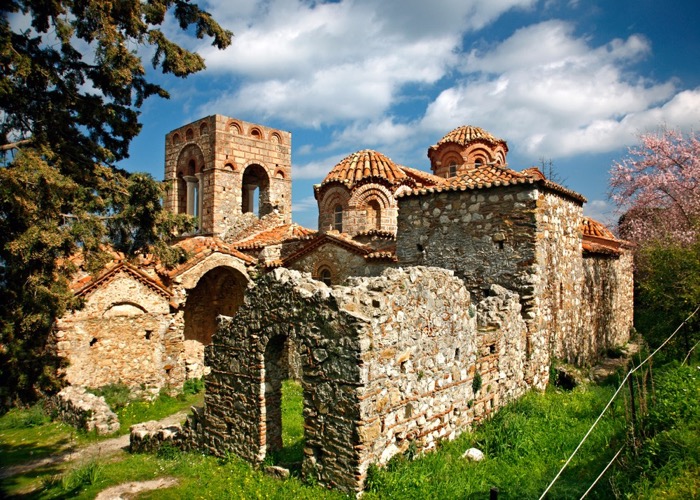
The ‘miracle of Moria’ was erected as a fortress in 1249 by the King of Achaia William Villehardouin.
It was recaptured by the Byzantines and later conquered by the Turks and the Venetians. The city was abandoned in 1832, leaving fascinating medieval ruins to stand in a location of exceptional beauty.
The founding of Mystras is connected with the first conquest of Constantinople by the Crusaders of the Fourth Crusade in 1204. The castle became the core of the later castle city of Mystras, one of the most important late Byzantine cities.
With the founding of the modern city of Sparta by King Otto in 1834, the movement of the inhabitants of Mystras to the new city began.
In 1989, Mystras was registered as a cultural asset on the list of World Cultural Heritage.
Pythagoreion and Heraion of Samos
Pythagoreion and Heraion of Samos - credits: gtp.gr
From the 3rd millennium BC, many cultures have inhabited this small Aegean island near Asia Minor.
The ruins of Pythagorion, an ancient fortified port with Greek and Roman monuments and an impressive aqueduct, and Heraion, the Temple of Hera of Samos, are still open to the public.
Ancient Samos (Pythagorion) was considered one of the most important cities of antiquity. In this area and the area of Hera, the oldest archeological findings date back to the 4th millennium BC.
Heraion of Samos is the Dipteros Temple of Hera, with a prominent Ionic style.
The only column that still stands today survives to about half of its original height. The temple's infrastructure is partially preserved up to the height of the masonry and the pillar. Herodotus characterized the temple as the largest in Greece.
The Archaeological Site of Philippi
The ancient Greek ruins of Philippi - credits: visitkavala.gr
Ancient Philippi is one of the most important and complete archeological sites of Northern Greece, with many monuments associated with the city's evolution from the Hellenistic period to the late Byzantine years.
Moreover, its strategic position, distinguished by Philip II, was recently upgraded with the construction of ‘Egnatia Avenue’.
After the dramatic battle in 42 BC, which defined the political history of the Roman state lived a period of prosperity as a Roman colony.
The Apostle Paul came to this lively urban center and founded the first Christian church on European soil in 49/50 AD, which was to change the countenance of both the city and the continent.
With the recognition of Christianity and its establishment as the state's official religion, imposing Christian temples were established, a panorama of early Christian architecture.
The ancient city of Philippi was founded on the edge of the swamps that covered the southeastern part of the Drama plain.
Its first inhabitants were settlers from Thassos, who founded in 360 BC the colony of Krinides, while the city flourished during the Hellenistic years.
The Sites of Patmos
Patmos - greeka.com
Patmos, in the Dodecanese, is famous as the island where Saint John the Theologian wrote the Gospel and the Apocalypse.
A monastery dedicated to the "beloved student" was discovered on the island in the late 10th century.
Since then, it has been a place of pilgrimage and a station of Greek Orthodox learning. The monastery complex dominates the island.
The old settlement of Chora, which is connected to it, includes religious and folk buildings.
The Monastery of Agios Ioannis, the Theologian in Patmos, is perhaps the most important monastic complex in the Aegean Sea. The founder of the monastery was Saint Christodoulos.
Built on a mountaintop, the monastery is surrounded by an irregular rectangular defensive enclosure.
It was allegedly built on the site of the temple of Artemis and an early Christian basilica.
The Holy Cave of the Apocalypse is one of the reference points of Patmos and Christianity worldwide.
The cave was the refuge of the Beloved Disciple of Jesus John in 95 AD, when the emperor Domitian exiled him to Patmos, punishing him for preaching the word of God in Ephesus.
According to Christian tradition, during John's stay in the cave, the rock was torn, and through three smaller slits, symbolizing the Holy Trinity, the voice of God was heard, which dictated to John the Holy Book of Revelation.
The Ancient Site of Aegion in Vergina
The Archaeological Site of Aegion in Vergina - credits: taxigoigoumenitsa.gr
The city of Aegion, the first capital of the Kingdom of ancient Macedonia, was discovered in the 19th century near Vergina in Northern Greece.
The most important monuments are the Palace, decorated with mosaics and frescoes, and the burial site, some of which date from the 11th century BC.
One of the royal tombs in the Great Tomb was recognized as the tomb of Philip II, who conquered all Greek city-states, paving the way for his son Alexander and the spread of the Hellenistic world.
At the southern end of the Macedonian plain, perched at the foot of Pieria, are Aiges, ‘the place with many herds,’ the first city of the Macedonians.
The first Macedonian urban center is located south of Aliakmonas, in the heart of the area that was for Herodotus the ‘Macedonian land,’ the cradle of the Macedonians.
In the same place, Alexander the Great is proclaimed king and begins the course that will lead him to establish himself as a legend.
Dominating the plains of the Aliakmonas River and built on the foothills of the Pierian Mountains lies the ancient royal city of Aiges, the political center of the ancient kingdom of Macedon.
With a history of thousands of years, the ancient city of Aiges was the seat of the Macedonian king.
The famous Argead dynasty of Macedonian kings succeeded in making the city a significant cultural, political, and economic center of ancient Greece.
A famous painter called Zeuxis worked here, as well as the renowned tragedian Euripides during the last years of his life.
The most famous kings of Aiges were Phillip II and, of course, the world-known Alexander the Great. In 168 BC, the city was left in ruins after the coming of the Roman army.
In 1977, the famous Greek archaeologist Manolis Andronikos discovered the royal city and showed its riches to the world.
Don't miss the chance to visit the palaces with the exquisitely-made mosaics, the public buildings, and of course, the ‘necropolis,’ the burial site of the Macedonian Kings.
Additionally, don't forget to pay a visit to the Archaeological Museum of Vergina, where golden wreaths, tombs, and glittering armors are only some of the artifacts that will have the chance to witness!
The Best Ancient Greek Ruins Not Included In The UNESCO World Heritage Site List
The Archaeological Site of Akrotiri in Santorini
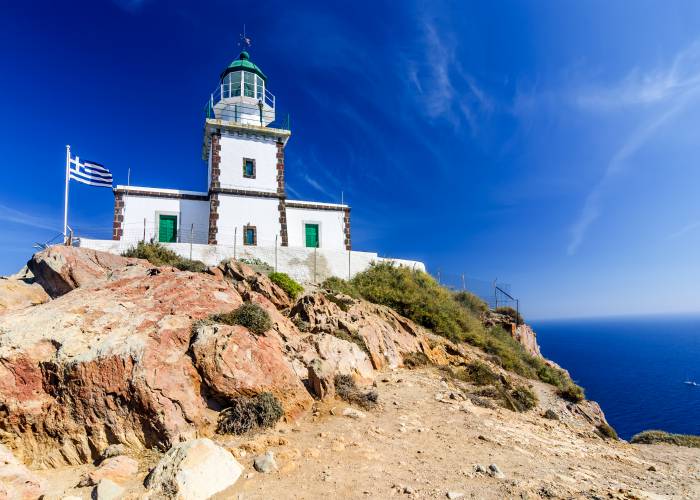
The island of Santorini is known worldwide for its spectacular deep blue sea and the stunning view of the island's caldera.
A fact, however, that never gets mentioned is that the island is an active volcano shaped after numerous violent explosions.
Santorini, or Thera -as it was called in antiquity- during the Bronze Age, was one of the most important centers of the Cycladic civilization. As proof stands the archaeological site of Akrotiri.
The settlement was substantial, covering a large area with hundreds of houses, public squares, and palace complexes, reflecting a prosperous civilization with high living standards. After the volcano's explosion, the site was buried under 60 meters of ash.
As a result, the settlement of Akrotiri was outstandingly preserved, including houses more than two stories high, roads, public facilities, priceless artifacts, and impressive frescoes.
The site of Akrotiri is the Aegean equivalent of Pompeii, capable of time-traveling the visitor back to the Bronze Age!
Akrotiri is one of the most impressive Greece attractions.
The Ancient Agora of Athens
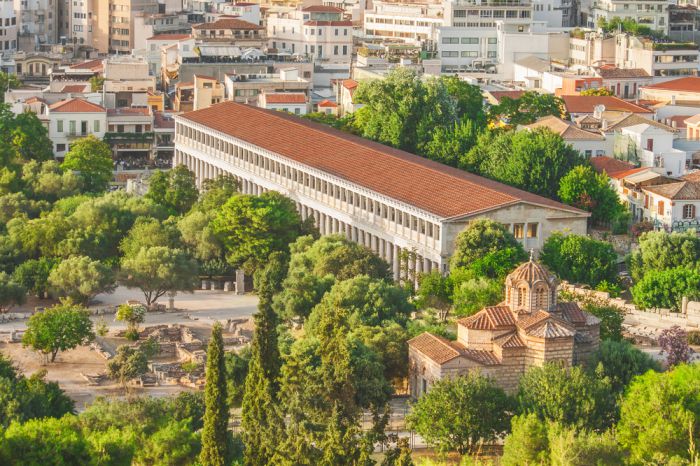
The area of the Ancient Agora has been a prominent testament of ancient Greece. It was established around the late Neolithic period as a cemetery.
However, Agora swiftly became both a cultural and commercial center of ancient Athens and shaped the city's political, religious, cultural, social, educational, administrative, philosophical, and financial life.
To comprehend Agora's importance, it should be noted that its grounds hosted the public library, the Stoa of Attalos, the Temple of Hephaestus, the Bouleutirion, the Tholos, and the music school of Agrippa, among many other significant buildings of the time.
The Stoa of Attalos was a present to the city from the staunch student Attalos, who felt gratitude for the knowledge he had gained in Athens. In the 2nd century BCE, it became the shopping center of the Athenians.
Despite most of the buildings being destroyed by hostile raids, the Stoa of Attalos was restored in 1956.
Today, it hosts exhibits as the site's archaeological museum. Another surviving building that still stands proud and stunning is the temple of Hephaestus.
Even if only a tiny part of the Ancient Agora is still standing, the importance of the archaeological site has diminished in no way, shape, or form.
On the contrary, it remains one of the top destinations for exploring Greece's history. Therefore, we suggest you put it high on your 'to-visit' list and marvel at its admirable beauty the first chance you get!
Knossos Palace in Crete

Knossos Palace, Crete - credits: KevTate999/Depositphotos.com
Knossos was the center of the Minoan civilization, which existed between 2,000 and 1,500 BC, and is directly connected to many tales of Greek Mythology, with 'Minotaur and the Labyrinth' and 'Icarus and Dedalus' being the most popular myths related to king Minoas and Knossos Palace.
The city of Knossos was inhabited from the 7th millennium BC until Roman times, and the Knossos palace is the largest preserved part of the palatial complex, reaching 22,000 m2.
It’s an engaging palace, consisting of plenty of workshops, shrines, storerooms, royal quarters, and other rooms.
Most of them are designed with amazing colorful murals depicting religious rites, Mother Nature elements, or emblazonments of the everyday Minoic life and civilization.
The palace suffered much damage throughout the years due to natural disasters. However, it remains awe-inspiring to anyone who visits it.
Let's not forget that it was built millions of years ago!
The Ancient Theater of Epidaurus
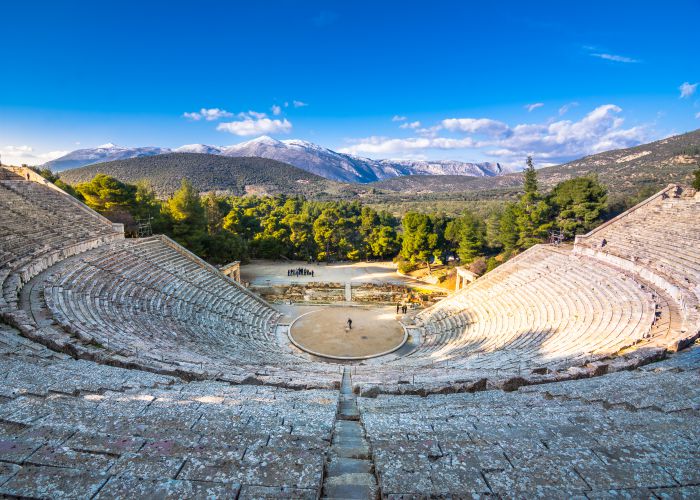
Epidaurus is where one can gaze in awe at the most renowned ancient theatre of Greece. During the late Classical era, Epidaurus was mainly known for the town’s Asclepion, an original remedial center.
Despite people’s belief that prayer would heal them, patients did receive treatment in Asclepion thanks to the experiential knowledge of the priestesses.
At first, Asclepius was not considered a God but was idolized as a hero. Later, a temple was built, and people worshipped him as a god.
The Asclepion signaled a transition from meddles attributed to supernatural powers to real medicine.
Therefore, the ancient edifice and relics of Asclepion are a reminder of the development of medical science back in the 4th century BC.
What is most impressive about the area and the original health center of Asclepius is that besides the medical center itself, one can find a whole building complex built to accommodate the needs of the people who visit its premises.
There was a building where ailing people could be hosted for as long as needed.
Additionally, there was a stadium where Games used to be held as a tribute to Asclepius. There were also two sanctums for the Greek God Apollo and Goddess Artemis, a bathhouse, a house for the priests, and, of course, the Theater of Epidaurus.
Unfortunately, only a few parts of the buildings survive today just like in many other Greek ruins.
However, archaeologists try to maintain the ruins, while there is also an archaeological museum where all the relics are exhibited.
Apart from its rich history, Epidaurus still holds the interest of both locals and visitors, with one of the most exciting theatre festivals taking place in the ancient Epidaurus Theater every year!
Final Thoughts
And here you have them. The most astonishing and fascinating ancient sites in Greece.
Some of which have earned the protection of UNESCO. Of course, there are many more fascinating sites in Greece, such as ancient Corinth and ancient Sparta; however, these are our favorites.
The monuments included in the World Heritage List are selected and approved based on their value as the best examples of human creative intelligence.
They are evidence of a significant exchange of human values and provide a unique or at least excellent testimony to a cultural tradition or culture that is still alive or has disappeared.
They are directly connected with critical stages of human and Greek history, and for this reason, they have outstanding universal value and are part of the common heritage of humankind.
This is why we try to include as many as possible in our Greece vacation packages!
Even the ruins that have not made it to the list are not to be missed.
They are examples of ancient Greek excellence and remain a testimony to a golden age that greatly affected Western civilization and continues to this day.
Now, call us biased, but aren’t they all heart-stopping?







